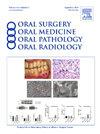Evaluation of ameloblastoma and odontogenic cysts with BRAFVE1 and CD56
IF 1.9
3区 医学
Q2 DENTISTRY, ORAL SURGERY & MEDICINE
Oral Surgery Oral Medicine Oral Pathology Oral Radiology
Pub Date : 2025-07-21
DOI:10.1016/j.oooo.2025.04.039
引用次数: 0
Abstract
Introduction
BRAFVE1 mutation-specific and CD56 antibodies have been proven to have diagnostic utility and expressed in ameloblastomas. Herein, we explored the utilization of these antibodies in cases of conventional (AMEL) and unicystic (UAMEL) ameloblastomas as well as other odontogenic cystic lesions including cysts that show features suggestive of unicystic ameloblastoma such as palisading basal cells and spongiosis without or minimal inflammation (QCYST).
Methods and Materials
Immunohistochemical analysis for BRAFVE1 and CD56 were performed in 23 AMEL; 9 unicystic AMEL (UAMEL), 6 QCYST, 8 dentigerous (DC), 5 radicular (RCYST) and one calcifying odontogenic cysts; 2 odontogenic keratocysts (OKC), 3 hyperplastic dental follicles (HDF) and 3 developing odontomas (ODONT). BRAFVE1 staining was determined as present or absent, while CD56 staining was assessed as negative, focal, or extensive.
Results
17/23 AMEL showed staining for both BRAFVE1 and CD56. CD56 (91.3%) performed superiorly compared to BRAFVE1 (73.9%). Only 1 of the 4 BRAFVE1 negative case affected the maxilla. Both antibodies were positive in 7/9 (77.8%) UAMEL cases. More interestingly, staining was observed in areas without the Vickers-Gorlin criteria. In lesions which were histologically diagnosed as DC but showed UAMEL features, both antibodies were negative in all cases but one showing focal CD56. Staining of basal and suprabasal cells was observed in OKCS. HDF and ODONT showed positive staining of included odontogenic rests with CD56. Finally, in the single COC, focal CD56 staining was observed. RCYST was negative for both antibodies.
Conclusion
BRAFVE1 and CD56 may disclose early ameloblastomatous changes not fulfilling the Vickers-Gorlin criteria in cystic odontogenic lesions. Both antibodies stain strongly in conventional ameloblastomas. Caution must be shown in using CD56 in other odontogenic lesions due to focal positive staining that could lead to diagnostic error.
BRAFVE1和CD56对成釉细胞瘤和牙源性囊肿的评价
brafve1突变特异性抗体和CD56抗体已被证明具有诊断用途,并在成釉细胞瘤中表达。在本文中,我们探讨了这些抗体在常规(AMEL)和单囊性(UAMEL)成釉细胞瘤以及其他牙源性囊性病变中的应用,包括表现出单囊性成釉细胞瘤特征的囊肿,如屏障性基底细胞和无炎症或轻微炎症的海绵状病(q囊肿)。方法和材料23例AMEL患者进行BRAFVE1和CD56免疫组化分析;单囊性AMEL 9例,q囊肿6例,牙源性(DC) 8例,根状(r囊肿)5例,钙化性牙源性囊肿1例;2例牙源性角化囊肿(OKC), 3例增生性牙毛囊(HDF), 3例发展中的牙瘤(odon)。BRAFVE1染色确定为存在或不存在,而CD56染色评估为阴性、局灶性或广泛性。结果17/23 AMEL均显示BRAFVE1和CD56染色。CD56(91.3%)优于BRAFVE1(73.9%)。4例BRAFVE1阴性病例中仅有1例影响上颌骨。在7/9(77.8%)的UAMEL病例中,两种抗体均为阳性。更有趣的是,在没有维克斯-戈林标准的区域观察到染色。在组织学上诊断为DC但表现为UAMEL特征的病变中,两种抗体在所有病例中均为阴性,但有一例显示局灶性CD56。OKCS观察基底细胞和上基底细胞染色。HDF和odon均显示CD56阳性染色。最后,在单个COC中观察到局灶性CD56染色。r囊肿两种抗体均为阴性。结论brafve1和CD56可揭示囊性牙源性病变早期不符合Vickers-Gorlin标准的成釉细胞瘤改变。这两种抗体在常规成釉细胞瘤中染色强烈。在其他牙源性病变中使用CD56必须谨慎,因为局灶性阳性染色可能导致诊断错误。
本文章由计算机程序翻译,如有差异,请以英文原文为准。
求助全文
约1分钟内获得全文
求助全文
来源期刊

Oral Surgery Oral Medicine Oral Pathology Oral Radiology
DENTISTRY, ORAL SURGERY & MEDICINE-
CiteScore
3.80
自引率
6.90%
发文量
1217
审稿时长
2-4 weeks
期刊介绍:
Oral Surgery, Oral Medicine, Oral Pathology and Oral Radiology is required reading for anyone in the fields of oral surgery, oral medicine, oral pathology, oral radiology or advanced general practice dentistry. It is the only major dental journal that provides a practical and complete overview of the medical and surgical techniques of dental practice in four areas. Topics covered include such current issues as dental implants, treatment of HIV-infected patients, and evaluation and treatment of TMJ disorders. The official publication for nine societies, the Journal is recommended for initial purchase in the Brandon Hill study, Selected List of Books and Journals for the Small Medical Library.
 求助内容:
求助内容: 应助结果提醒方式:
应助结果提醒方式:


